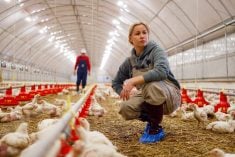CHICAGO (Reuters) — Hog weights in the benchmark Iowa/southern Minnesota market tipped the scales at their highest level ever with cooler fall weather and more affordable feed allowing animals to pack on pounds quickly, analysts and economists said.
On average, hogs in the Iowa/southern Minnesota market for the week ending Nov. 2 weighed 279.7 lbs. That was up 7.6 lbs from a year earlier, easily topping the most recent record high of 278 lbs in April.
The 7.6 lb jump was the largest yearly gain for the week since December 2010, and extended the string of weekly increases to 10 in a row. Last week’s weights were up 1.9 lbs from the previous week.
Read Also

B.C. ostriches culled, CFIA confirms
Ostriches on an embattled Edgewood, B.C. farm have been culled after a prolonged legal battle, the Canadian Food Inspection Agency has confirmed.
“They didn’t just step over the line into new record territory, they leaped over the line,” said independent market analyst Bob Brown in Edmond, Oklahoma.
Analysts, economists and traders closely track the Iowa/Minnesota hog data because the region boasts the largest concentration of hogs and pork processing facilities in the United States.
Brown attributed the record-high hog weights to the long-running trend of improved swine genetics. He cited the seasonal shift from torrid summer heat to more comfortable autumn weather. Extreme heat and sultry humidity cause animals to eat less, which slows weight gains.
Hogs at this time of year are dining on less-expensive newly harvested corn, the main ingredient in livestock ration, thanks to the bumper fall crop.
Less-costly feed, coupled with relatively high prices paid for slaughter-ready hogs this fall, helped producers turn a profit for the first time in nearly a year.
“Corn’s a lot cheaper and hog prices are a lot higher than a year ago. That’s a good combination if you’re in the hog business,” said University of Missouri livestock economist Ron Plain.
Hogs got heavier this fall as some producers held them back to capitalize on the better money for their animals, he said.
Although swine weights have marked a fresh all-time high, it is not enough to offset the unexpected decline in the number of hogs winding up at packing plants.
Packers last week processed an estimated 2.272 million hogs, 87,000 fewer than the same period a year earlier.
Based on last week’s slaughter, Brown estimated that the 7.6 lb weight gain compared with last year is equivalent to 475.5 million lbs of pork, which was down from 483.0 million lbs last year.
“Every hog that is coming to market is adding 2.7 percent more pork to the market than a year ago. If the total head count is down, the volume remains down,” said Brown.
Last year, hog farmers downsized their herds to counteract record-high corn prices after drought severely damaged crops, resulting in less supplies for packers to draw from now.
A few hog farmers likely delayed sending their pigs to market following the lapse of crucial USDA data during the federal government partial shutdown in October, said Plain.
He said the impact of a deadly pig virus on U.S. hog farms may be one reason that hog slaughter was down more than three percent over the past four weeks rather than up 1.5 percent, as suggested in USDA’s last quarterly hog report issued in September.
Reports of the Porcine Epidemic Diarrhea Virus (PEDv), which is fatal to baby pigs, began appearing in May. Cases of the virus subsided during hot summer weather, but it has recently been on the rise in hog-rich states such as Iowa and North Carolina as temperatures turned cooler.
PEDv does not affect humans and is not a food safety concern.
“We may be getting to the point where the impact of PEDv is showing up. We’re about in the time frame where some of the pigs that died from the virus may not be showing up at hog slaughter plants today,” Plain said.
Brown and Plain are expecting hog weights to be higher over the next month or so, but to taper off during frigid winter weather when animals eat more to keep warm but do not put on weight.














